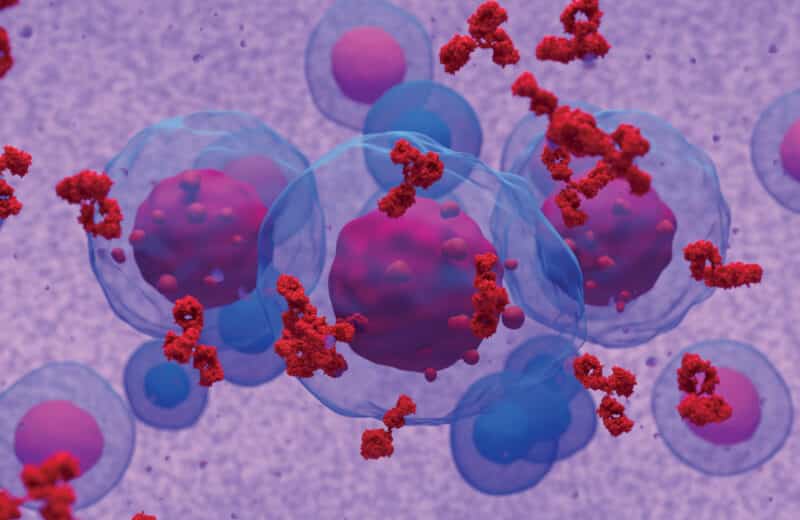Above photo: Carey August, MD
Out of the spotlight, pathologists help detect disease
By Nancy Maes
When former President Jimmy Carter announced in August that a mass on his liver was a stage IV melanoma, along with four spots on his brain, the diagnosis seemed surprising since melanoma is usually associated with the skin.
Knowing the type of cancer—whether a mass is liver cancer originating in that organ or melanoma that spread from elsewhere in the body—is of critical importance for doctors, who can devise a treatment plan with drugs tailored to the type of cancer. The cellular detectives behind the discovery? Pathologists working in the laboratory.
“It’s not as though doctors opened Carter’s belly and looked in and saw a sign that said, ‘I’m a melanoma,’” says Carey August, MD, director of anatomic pathology at Advocate Illinois Masonic Medical Center, who was not involved with Carter’s cancer but read details in the press. “Pathologists had to figure that out, so in some ways, we are detectives.”
Pathologists first look at the tissue sample that has been removed from the patient. “We can tell by the look of the cells if they are malignant, because we know the characteristics of cells in every part of the body. We know if the features we see under the microscope indicate it is malignant because we’ve trained our eyes, just as art historians train their eyes to recognize a Chagall or a Rubens,” August says.
The pathologist then zeros in on specifics. “Cancer is a global term, and we need to know which type of cancer it is. Without pathologists, there would be no precise diagnosis,” says Thomas Krausz, MD, director of anatomic and surgical pathology at The University of Chicago Medicine, who was not involved in President Carter’s case. “After pathologists examine a representative tissue sample with the naked eye for cancer, they then preserve the tissue in a fixative solution, embed it in a paraffin block, cut off a very thin slice and stain it, most commonly with special dyes, so they can see the details of the individual cells under the microscope.”
Details of the meticulous work performed by pathologists is not well known because it is done away from the spotlight. “The difference between the surgeons and oncologists and the pathologists like myself is that we do not meet the patients but only the material that is removed from the patients,” Krausz says. “But in most hospitals in the U.S., the pathologist is one of the specialists on the multidisciplinary tumor board that meets every week to discuss the actual cases.”
Pathologists help solve the mystery of cancer so that the specialists can figure out the best way to treat the disease. While Carter had a family history of pancreatic cancer, his mass was neither pancreatic cancer nor liver cancer, August says. Instead, it was likely related to an undetected past skin melanoma.
“In Carter’s case, the pathologist might have recognized the features of melanoma under the microscope. Or he might not have known right away and used some additional staining techniques to narrow down the possibilities or confirm that it was a melanoma,” she says. “Sometimes the results are iffy, and we go back to the drawing board over and over again and do the detective work until we figure it out.”
Additional tests are often necessary, Krausz says, because the pathologist must identify the sub-type of the malignant melanoma as well as gene mutations. “It is very common in referral institutions to send tissue to the molecular pathology laboratory for genetic testing because within the subtypes of melanoma, you can have different gene mutations, which are important for the oncologist to know when deciding on one of the treatment possibilities,” Krausz says.
“The whole approach to melanoma treatment has changed in the past five years with the discoveries of molecular alterations and mechanisms of manipulating the immune system to encourage it to kill the melanoma cells,” Krausz says. “The concepts of personalized medicine and targeted therapy are very important in this era, so when we make a diagnosis, we try to be as specific as possible in each individual case.”
President Carter’s treatment includes radiation for the spots on his brain and a new drug called Keytruda (pembrolizumab) that boosts the immune system so that it can attack the cancer cells.
Typically, the paraffin block with the biopsy specimen and the slides are kept by the hospital for 10 years, August says. “As we have more and more information about new targets for treating patients, we may have new tests we can perform. If a patient has a recurrence of the cancer, there may be new tests we can perform that will facilitate the use of new medications. Or, if the patient has a secondary cancer, we can compare it to see if this is a metastasis or a new cancer.”
Now, and in the future, pathologists working behind the scenes will perform the essential work of sleuthing out the clues that reveal to the medical team the treatment option with the best potential for success. As the detectives of the medical world, they continue to solve many medical mysteries, aiding other physicians as well as patients.












